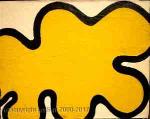Al Held
Al Held
Place: Brooklyn
Born: 1928
Death: 2005
Biography:
Al Held was an American Abstract expressionist painter. He was particularly well known for his large scale Hard-edge paintings. As an artist, multiple stylistic changes occurred throughout his career, however, none of these occurred at the same time as any popular emerging style or acted against a particular art form. In the 1950s his style reflected the abstract expressionist tone and then transitioned to a geometric style in the 60s. During the 1980s there was a shift into painting that emphasized bright geometric space that’s deepness reflected infinity. From 1963 to 1980 he was a professor of art at Yale University.
Born in Brooklyn, New York in 1928, he grew up in the East Bronx, the son of a poor Jewish family thrown onto welfare during the depression. Held showed no interest in art until leaving the Navy in 1947. Inspired by his friend Nicholas Krushenick, Held enrolled in the Art Students League of New York. He originally thought about studying in Mexico under the prominent muralist David Siqueiros, who created gigantic pieces that contained intense political material. However, the G.I. accreditation that he planned on using to help with his travels was not accepted at the school he planned on attending. In 1951, using the support of the G.I. Bill, he went to Paris for two years, to study at the Académie de la Grande Chaumière. In Paris, he decided that realism was not for him and moved into abstraction. During the early 50s Avant-garde painters in the United States were receiving fresh inspiration from abstract expressionists such as Jackson Pollock, Mark Rothko, and Willem De Kooning. Together these artists brought a new way of thinking that influenced Held. He returned to New York in 1953 and married Giselle Wexler, with whom he had a daughter, Mara. After the break-up with his wife, he went to San Francisco where he met the soon-to-be postmodern dancer and choreographer Yvonne Rainer. They moved together to New York in 1956, got married in 1957 to split up in 1959. Then in 1969, he married the sculptor, Sylvia Stone.[citation needed]
The Galerie Huit in Paris was where his first exhibition was set up in 1952. However, the art scene in New York was starting to gain new popularity and Held moved back there. During one of his solo Abstract expressionist exhibitions in 1959, Held's large-scale paintings of colourful, simple abstract geometric forms gained increasing recognition in America and Europe. In 1962, he was appointed to the Yale University Faculty Of Art (where he would teach until 1980). In 1965, the critic Irving Sandler curated the critically acclaimed Concrete Expressionism show at New York University featuring the work of painters Al Held and Knox Martin and the sculptors Ronald Bladen, George Sugarman and David Weinrib.
In 1964, Held was awarded the Logan Medal of the arts and received a Guggenheim Fellowship in 1966. Feeling that he'd reached the end of his style's potential, he shifted in 1967 to black and white images that dealt with challenging perspectives and "spatial conundrums". Some critics dismissed this work as simply disorienting; others declared it Held's finest achievement to date. By the late 1970s, he had re-introduced colour to his work. In 1988 he was elected into the National Academy of Design as an Associate member, and became a full Academician in 1994.
In his later years, Held earned commissions of up to one million dollars. In 2005, he completed a large, colourful mural in the New York City Subway system, at Lexington Avenue / 51st – 53rd Streets station.
Three of Held's murals were in the original WTC 7 building.
At age 76, Held was found dead in his villa swimming pool near Camerata, Italy, on July 27, 2005. It is believed he died of natural causes.
The most distinguishing part of Held’s pigment paintings were the thick brush strokes of paint in random directions that are reminiscent of Abstract Expressionism. These strokes were short, gestural and are commonly referred to as action painting. The colors included earth tones that are muted and spread around chaotically. Typical for many of these paintings was no foreground or background and sections were splashed with drips. As time went forward in the fifties, Held began to lengthen his gestures and combined strokes into triangles, circles, and rectangles. This was alluding to the geometric abstractions that started at the end of 1959.
During the late 50s gestural painting was something that Held had begun to lose interest in. He and a few other artists such as Morris Louis and Kenneth Noland felt a growing problem emerge. The style had brought a large number of mediocre artists and become overdone for them. By 1960 he had succeeded in finding an alternative method given the label hard edge. In other ways it has been described as post-painterly abstraction, new abstraction, and cool art. The famous exhibition organizer Irving Sandler has been known to characterize it as concrete expressionism.[citation needed] The development of this style also led Held to change his medium from oil to a water-based acrylic. These paintings had vivid colors geometric configurations around positioned throughout the canvas resembling a mural. All of the paintings were nonobjective meaning the artwork does not represent a person, place or thing. Untitled from 1964, in the collection of the Honolulu Museum of Art is an example of the artist's hard-edge style.
More...
Wikipedia link: Click Here








